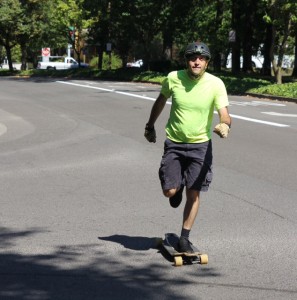We’re kicking off a regular series called My View. It’s an opportunity for people to share their view on aspects of transportation. Today, we take a look at skateboards.
By Cory Poole
The first step to thinking about skateboards as active transportation is forgetting everything you know about skateboarding. Once you have removed the flip tricks, grinds and big airs from your mind, you can start to see skateboarding as a really practical way to get around.
The last ten years has seen explosive growth of the longboarding industry fueled largely by better, more affordable equipment, and teen riders. Many former college students have continued longboarding into their adult life. Increasing numbers of adult riders have also picked up longboarding as a less injury prone alternative to traditional skateboarding.
A modern longboard (or a skateboard with a long wheelbase) can easily cruise around 10 MPH, with a small amount of training they can steer and stop as well as many bicycles. Skateboarding is a healthy physical activity. Skateboards are inexpensive to purchase and maintenance is minimal. Transition on and off of public transportation is a breeze and skateboards can easily stored at home, work or school. Skateboards are an ideal form of transportation for those trips that are to far to walk but to close to justify getting on the bike or in the car.
So what’s holding skateboard transportation back? Probably the largest single contributor to skateboarding’s image problem is the social stigma around riding.
Early on, skateboarding was vilified as an activity of misguided youth. This image was embraced by early skateboarders and an outsider culture was developed which valued isolation and ambivalence for authority. Whether this image of skateboarding is accurate or not is irrelevant.
The result is that many city governments see skateboarding as something to be tolerated at best or more often banned entirely. Skateboarding bans often do not eliminate skateboarding, but rather bans drive the activity underground where constructive interaction with the skate community becomes difficult or impossible.
What is the solution? There are already tens if not hundreds of thousands of people using skateboards as active transportation. The real test will be if transportation policy will follow suit. In a few cities like Portland, Oregon, where I live, skateboarding is not only legal, it is encouraged.
This removes the social stigma which might keep new riders off the streets. After 10 years Portland’s skateboard ordinance has been a success story. More cities should look at Portland’s example and give skateboards legal access to the road. If a road is safe enough for bicycles to use it is also safe for skateboarding. When issues arise, laws should address the the behavior in question rather then banning skateboarding entirely.
The future of transportation in America must be multi-modal. Skateboards can and should be an important element of this transportation landscape.
Cory Poole is a skateboard transportation advocate in Portland Oregon, and is co-founder of the Northwest Skate Coalition.
If you’re interested in submitting a piece for My View, email us at curbingcars@gmail.com.

